Jesse Martin, Trends Analyst, Smooch
Smooch’s 2019 State of Messaging report was released last month, featuring unique insights from 34 marketing, product and customer experience experts about the future of conversational business.
The report looks at how messaging can be the first point of contact in a customer journey and how emerging business messaging channels can be used to engage and convert customers. I pulled my three favourite takeaways from the report that demonstrate how conversational marketing is becoming much more than a buzzword.
Conversational Leads
Click-to-message ads have come to Facebook and WhatsApp, while AdLingo is creating interactive advertising experiences with chatbots built in. Dave Gerhardt, VP of Marketing at Drift says, “I think we’re about to enter the hardest decade for marketers but the best decade for brands,” remarking that it’s becoming more difficult than ever to reach customers – so why not plant yourself where they already are?
Conversations with businesses can be initiated over Apple and Google Maps, thanks to the limited releases of Apple Business Chat and Google My Business. Customers can chat with businesses in the same manner they would with friends on iMessage. Making messaging available on maps allows brands to generate leads where they’re already primed to be discovered. These are conversations that are waiting to happen.
Brands are emerging with messaging at the core
Hussein Fazal, Co-founder and CEO of SnapTravel, predicts that “in 2019, we expect customers to start searching for brands over messaging first, before looking up their website for customer support.”
SnapTravel, which connects customers to discounted hotel rooms on Messenger, is part of a new generation of startups that were born conversational. Members-only personal shopping startup Jetblack lets customers text “nearly any shopping request” and have it delivered within 24 hours, while Threads deals designer clothes on most major messaging platforms. No need to download an app.
Jetblack Co-founder Jenny Fleiss says it’s important that conversational commerce isn’t just “tech for tech’s sake, but [an experience] that meaningly helps the consumer.”
Chatbots are getting better at their jobs
Depending on the industry, bots could handle anywhere from 30-70% of customer requests – and that’s before AI becomes part of the equation.
Phil Gray, EVP of Business Development at Interactions emphasizes the combination of “true human intelligence” and conversational AI as key technologies that will enable bots to perform. You can call this the new theory of multiple intelligences.
It’s important to recognize that while bots have scalability and pervasive reach, the combination of human agents and bots can deliver a winning strategy.
Look out for channels that can carry the bot-to-human handoff when necessary. “It’s clear that if you combine bots with human agents you can deliver really amazing experiences,” Conversocial CEO Joshua March says. “I think every major brand will be taking this approach in 2019.”
Industry insiders are optimistic about messaging and its potential to deliver personal, convenient, and consistent customer experiences – and they’re frustrated that the conversational future hasn’t come fast enough.
With customers eager to chat and tools becoming available for businesses to build on messaging, it’s up to brands and software makers to turn these possibilities into dynamic experiences.









